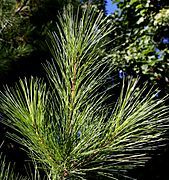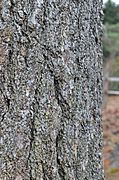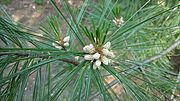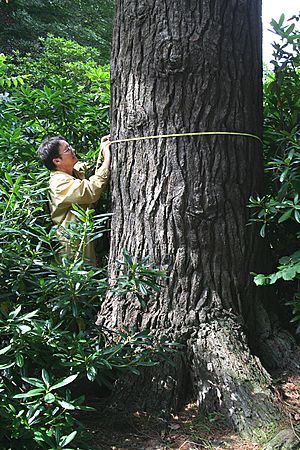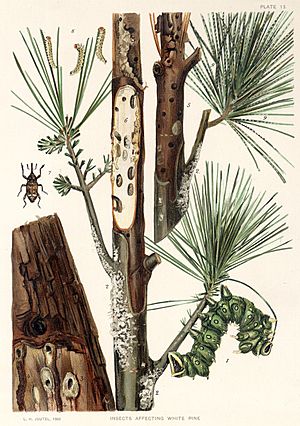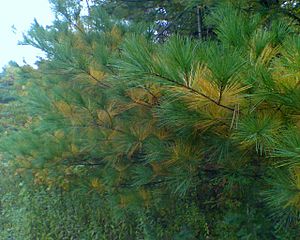Eastern White Pine facts for kids
Quick facts for kids Eastern White Pine or Northern White Pine |
|
|---|---|
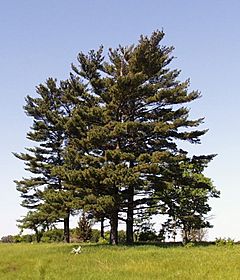 |
|
| Group of trees | |
| Conservation status | |
| Scientific classification | |
| Kingdom: | |
| Phylum: | |
| Class: | |
| Order: | |
| Family: | |
| Genus: | |
| Subgenus: |
Strobus
|
| Species: |
P. strobus
|
| Binomial name | |
| Pinus strobus |
|
The Eastern White Pine (Pinus strobus) is a very large pine tree. It grows naturally across eastern North America. You can find it from Newfoundland in Canada, west to Minnesota, and south along the Appalachian Mountains to Georgia. It is the state tree of Maine.
Contents
Eastern White Pine: A Giant Tree
Where Does It Grow?
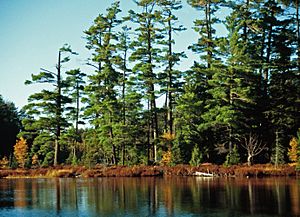
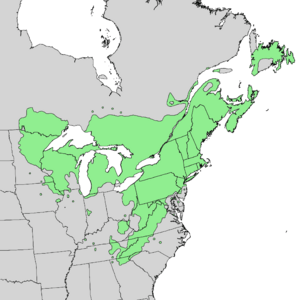
The Eastern White Pine lives in the cool, mixed forests of eastern North America. It likes soil that drains well or is sandy. It also prefers places with humid air. However, it can also grow in wet, boggy areas or on rocky hills. In mixed forests, this tall tree stands out above many others. This includes some large hardwood trees. It provides food and shelter for many forest animals. These include birds like the red crossbill and small animals like squirrels.
Long ago, Eastern White Pine forests covered huge parts of North America. But from the 1700s to the early 1900s, many trees were cut down. Now, only about one percent of these old, untouched forests remain.
Some of these old forests are now protected. You can find them in places like Great Smoky Mountains National Park. Other protected areas include Algonquin Provincial Park in Canada. In the United States, you can see them in Michigan and Wisconsin. There are also protected areas in Minnesota, Pennsylvania, and North Carolina.
Sometimes, small groups or single old Eastern White Pines are found. These are in places like Ordway Pines in Maine. They are also in Ice Glen in Massachusetts and Adirondack Park in New York.
This tree has also been planted in other parts of the world. It is now growing naturally in the Carpathian Mountains in the Czech Republic and southern Poland. It spread from trees that were planted for decoration.
What Does It Look Like?
Like other white pines, its leaves are called "needles." They grow in bundles of five. Sometimes, rarely, they grow in bundles of three or four. These needles are flexible and bluish-green. They are about 5 to 13 centimeters (2 to 5 inches) long. They stay on the tree for about 18 months. Then they fall off in the autumn.
The tree's cones are long and thin. They are about 8 to 16 centimeters (3 to 6 inches) long. When open, they are about 4 to 5 centimeters (1.5 to 2 inches) wide. The seeds inside are small, about 4 to 5 millimeters (0.16 to 0.2 inches) long. They have a thin wing, about 15 to 20 millimeters (0.6 to 0.8 inches) long. The wind helps spread these seeds. The tree makes the most cones every 3 to 5 years.
Eastern White Pines can live for a very long time. Many mature trees are 200–250 years old. Some can live for over 400 years. One tree near Syracuse, New York was found to be 458 years old. Trees in Michigan and Wisconsin were about 500 years old.
How Tall Can It Get?
The Eastern White Pine is the tallest tree in eastern North America. Before colonial times, some trees were said to grow as tall as 70 meters (230 feet). It's hard to know for sure how tall trees were back then. But it's possible some Eastern White Pines reached this amazing height.
The tree grows about 1 meter (3 feet) taller each year. This fast growth happens between the ages of 15 and 45 years. After that, it grows more slowly. The tallest living trees today are about 50 to 57.55 meters (164 to 189 feet) tall.
The Appalachian Mountains in the southern United States have the tallest trees. One famous tree is called the "Boogerman Pine." It is in the Great Smoky Mountains National Park. It is 57.55 meters (189 feet) tall. This makes it the tallest accurately measured tree east of the Rocky Mountains. Before a hurricane broke its top in 1995, it was even taller, about 63 meters (207 feet).
In the northeastern USA, many tall Eastern White Pines exist. Cook Forest State Park in Pennsylvania has over 100 trees that are 45 meters (148 feet) or taller. The "Longfellow Pine" in this park is the tallest in the Northeast. It is 55.96 meters (183.6 feet) tall.
How Wide Are Its Trunks?
The trunks of large Eastern White Pines can be very wide. Their diameters range from about 1.0 to 1.6 meters (3.3 to 5.2 feet). This means their circumference (distance around) is about 3.1 to 5.0 meters (10 to 16 feet). It is very rare to find a single-trunked white pine wider than 1.45 meters (4.8 feet).
What Problems Does It Face?
Eastern White Pines are somewhat resistant to fire. This means that after a fire, older trees can help re-seed the burned areas. When these trees grow close together, their lower trunks usually have no branches.
However, two main problems can harm or kill these trees. One is the white pine weevil, an insect. The other is a fungus called white pine blister rust. This fungus came from other parts of the world.
Dealing with Blister Rust
In the early 1900s, white pine blister rust killed many mature pine trees. Sometimes, 50–80% of the trees in a grove would die. This fungus needs another plant to complete its life cycle. These plants are usually native gooseberry or wild currant bushes.
To fight the rust, foresters tried to remove all these other host plants. People were encouraged to pull up and destroy all native gooseberry and wild currant plants. This was done to protect the timber industry. Today, wild currants are less common in New England. Planting them is often discouraged. However, new types of commercial currants have been grown that can resist the rust. Now, only about 3% of white pines die from this rust.
How Have People Used It?
Lumber for Homes and More
In the 1800s, cutting down white pine forests in the Midwest was very important. It helped America expand westward. Hundreds of thousands of white pines were cut and sent to lumber yards.
Eastern White Pine wood was very popular. It was easy to cut. Large, smooth boards without knots were common. Many colonial homes used pine for walls, floors, and furniture. Loggers also liked pine because its logs could be stored for a year or more after being cut. Most hardwood trees, like oak or maple, must be cut into boards right away. If not, large cracks can form in their trunks.
Pine was often used for flooring before the American Civil War. But the wood is soft. It can wear down over time. George Washington chose harder southern yellow pine for his home, Mount Vernon.
Tall Masts for Ships
During the time of large sailing ships, tall white pines were very valuable. These trees were called "mast pines." Agents of the British King would mark these trees with a special symbol. This meant they were saved for the British Royal Navy.
Special boats were built to carry up to 50 pine trunks. These trunks would become ship masts. The wood was often squared off after being cut. This made it fit better into the ships. A 30-meter (100-foot) mast was about 0.9 meters (3 feet) wide at the bottom. A 36-meter (120-foot) mast was about 1.2 meters (4 feet) wide at the bottom.
The King marking these trees was very unpopular in the colonies. It led to the Pine Tree Riot in 1772. This act of rebellion helped start the American Revolution. During the war, colonists cut down many mast pines themselves.
The first masts on the USS Constitution warship were single trees. Later, they were replaced with stronger, layered masts. These could better handle cannonballs.
How Is It Used Today?
Modern Lumber Uses
Today, Eastern White Pine is widely grown in tree farms. These farms are within the areas where it naturally grows.
Freshly cut Eastern White Pine wood is a creamy white or light yellow color. But wood that has aged for many years turns a deep golden tan. Sometimes, you can find light brown pine boards with unusual yellowish or reddish colors. This is called "pumpkin pine." It is thought that slow-growing pines in old forests develop these colors. The soil and genetics of the tree might also play a role.
This wood is also liked by people who make patterns. This is because it is easy to work with.
Food and Medicine from the Pine
Eastern White Pine needles have a lot of Vitamin C. They have five times more Vitamin C than lemons, by weight. You can make a good herbal tea from them. The inner bark of the tree is also edible. It is also a source of a healthy substance called resveratrol. In the 1700s, Carl Linnaeus noted that animals fed pine bark bread grew well.
Pine tar is made by slowly burning pine roots or branches. Pine tar mixed with beer was used to remove worms from the body. Pine tar mixed with sulfur can help treat dandruff. It is still used in some products today. Pine tar can also be used to make turpentine.
- Native American Traditional Uses
The word "Adirondack" comes from an Iroquois word. It means "tree-eater." This name referred to their neighbors, the Algonquian peoples. These people would collect the inner bark of this tree and others during winter when food was scarce. The soft inner bark was carefully taken off the hard outer bark. It was then dried and pounded into a flour. This flour could be used alone or mixed with other starchy foods.
The Ojibwe Indians would cook the young male cones with meat. They said they were sweet and not sticky. The seeds are also sweet and good to eat.
Pine resin (sap) was used by different tribes. They used it to make baskets, pails, and boats waterproof. The Chippewa also used pine resin to treat infections and bad wounds. This is because pine resin has substances that fight germs. A wet pulp from the inner bark, or pine tar mixed with beeswax, was put on wounds to prevent infection.
Growing White Pines
Pinus strobus is grown by plant nurseries as an ornamental tree. People plant it in gardens and parks. This tree is easy to care for and grows fast. If it is trimmed regularly, it can even be shaped into a hedge. Some types of this tree are used in bonsai.
Christmas Trees!
Smaller Eastern White Pines are popular as live Christmas trees. These trees are known for keeping their needles well. They do not drop them easily, even after being cut. They are also good for people with allergies because they have little to no smell. A 1.8-meter (6-foot) tree usually takes about 6 to 8 years to grow.
People often prefer trimmed trees. This is because they have the classic conical Christmas tree shape. Naturally grown ones can become too thick for larger ornaments. The branches of the Eastern White Pine are also used to make holiday wreaths and garlands. This is because their needles are soft and feathery.
Symbols and Meanings
The Eastern White Pine is the Provincial Tree of Ontario, Canada.
In the United States, it is the State Tree of Maine (since 1945) and Michigan (since 1955). Its "pine cone and tassel" is also the State Flower of Maine.
Sprigs of Eastern White Pine were worn as symbols of Vermont identity. This was during the time of the Vermont Republic. You can see them in a stained glass window in the Vermont State House. They are also on the Flag of Vermont and on the naval flags of Massachusetts and Maine.
The Native American Haudenosaunee (Iroquois Confederation) called it the "Tree of Peace".
Images for kids
See also
 In Spanish: Pino de Weymouth para niños
In Spanish: Pino de Weymouth para niños



